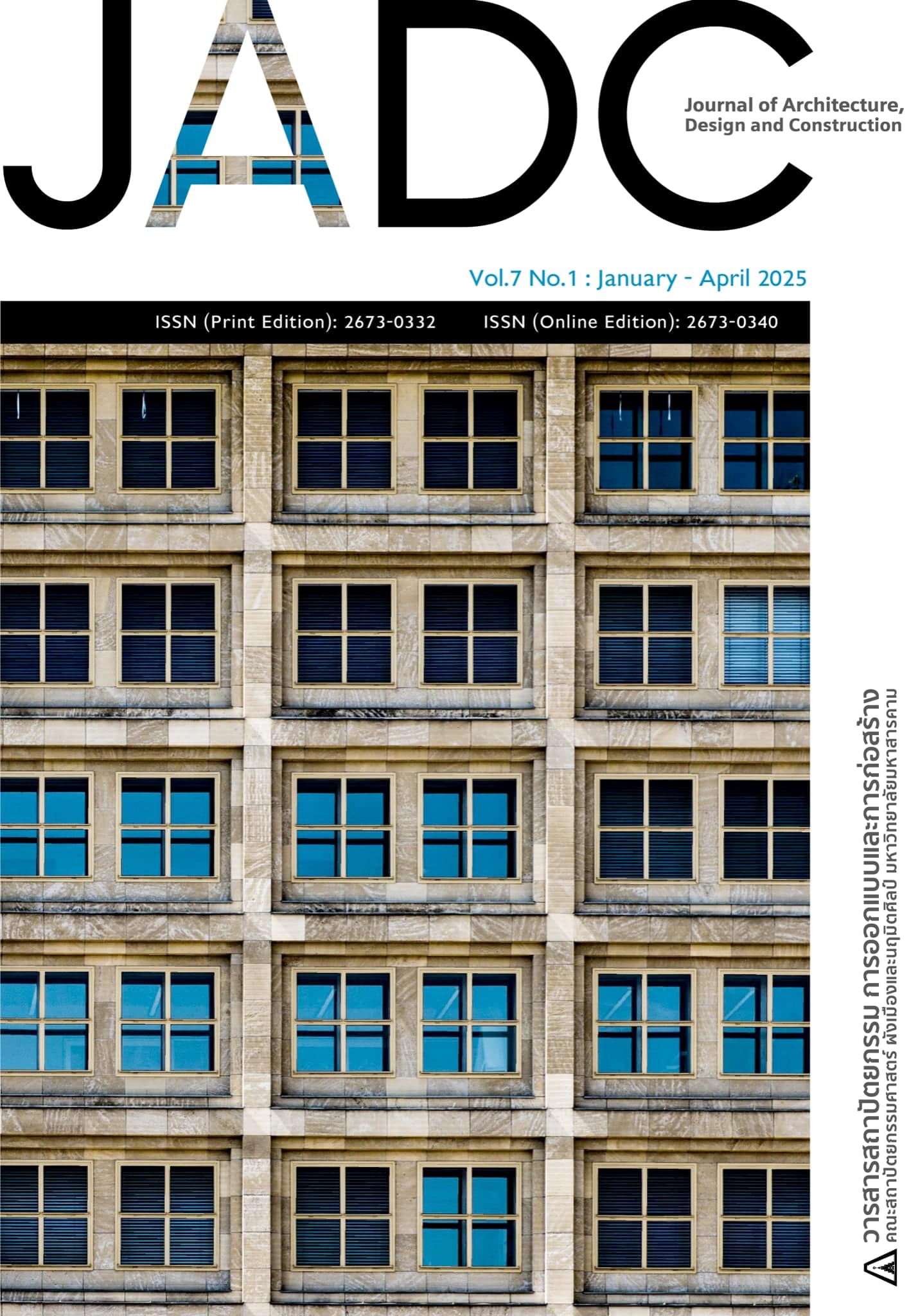The Promoting of Well-being Learning City through Herbs Garden Design, Bueng Yitho Municipal Kindergarten School (Fa Rangsit Village)
Main Article Content
Abstract
This research aims to design the herb garden area of Bueng Yitho Municipal Kindergarten school (Fa Rangsit Village) through a participatory process to promote the well-being of the learning city (herbs) of Bueng Yitho Municipality. The research method was qualitative, consisting of surveying herbs in Bueng Yitho Municipality to design a database for the herb garden, along with involving the school and related local agencies. Additionally, interviews and observations were conducted to gather results. The findings revealed that the design of the herb garden should promote imagination, creativity, and the development of early childhood learning. Consequently, the herb garden served as a learning space outside the classroom, where a science-based herb garden learning activity project was implemented. This project focused on three skills: 1. "Touch me, what are the herbs?", 2. "Smell to know what I am", and 3. "Color for tasting." These activities formed part of the early childhood learning process, creating knowledge on good health through herbal learning within the school premises. Furthermore, this initiative will contribute to the strength of the local herb knowledge network, aligning with the plans and goals of promoting a learning city (herbs) in Bueng Yitho Municipality in the future.
Downloads
Article Details

This work is licensed under a Creative Commons Attribution-NonCommercial-NoDerivatives 4.0 International License.
The articles published in the Journal of Architecture, Design, and Construction are the intellectual property of the Faculty of Architecture, Urban Planning, and Fine Arts, Mahasarakham University.
References
กระทรวงศึกษาธิการ. (2560). หลักสูตรการศึกษาปฐมวัย พุทธศักราช 2560 สำหรับเด็กอายุต่ำกว่า 3–5 ปี. https://bit.ly/3DFErBL
กองการแพทย์ทางเลือก. (2561). คู่มือการใช้สมุนไพรในโรงเรียน. https://bit.ly/3FufSrX
กุสุมาลี โพธิปัสสา. (2562). การส่งเสริมพัฒนาการเด็กปฐมวัยโดยใช้ภูมิปัญญาท้องถิ่น. วารสารโรงพยาบาลสกลนคร, 22(3), 115–128.
ธนภูมิ วงษ์บำหรุ, วรากร สงวนทรัพย์, ปริญญา มรรคสิริสุข และ วิกันดา สีคง. (2565). การออกแบบพื้นที่การเรียนรู้คลองรังสิตประยูรศักดิ์ผ่านการกระบวนคิดเชิงออกแบบ. วารสารวิชาการคณะสถาปัตยกรรมศาสตร์ สจล., 35(2), 144–163.
มานิตา ลีโทชวลิต อรรถนุพรรณ. (2561). ปลูกและเติบโต: การทำงานสวนสำหรับเด็กปฐมวัย. วารสารมนุษยศาสตร์ สังคมศาสตร์ และศิลปะ มหาวิทยาลัยศิลปากร, 11(3), 177–191.
ศิริวรรณ อุบลเลิศ และ ณัฏฐ พิชกรรม. (2557). การศึกษาองค์ประกอบพื้นฐานสำหรับการออกแบบสวนสมุนไพรอย่างครบวงจร.
ใน การประชุมวิชาการของมหาวิทยาลัยเกษตรศาสตร์ ครั้งที่ 52: สาขาสถาปัตยกรรมศาสตร์และวิศวกรรมศาสตร์ (น. 340–347). มหาวิทยาลัยเกษตรศาสตร์.
ศิริวิมล ศรีมีทรัพย์. (2563). แนวทางการออกแบบสวนเพื่อกิจกรรมพืชสวนบำบัดสำหรับเด็กและเยาวชนในสถานพินิจและคุ้มครองเด็กและเยาวชน จ.ปทุมธานี. วารสารศิลปศาสตร์และอุตสาหกรรมบริการ, 3(2), 55–64.
ศรีวิภา ขวัญช่วย, มาลี แก้วสุขศรี, ชมรรัตน์ พะยุหะ, นรีรัตน์ ศรีสวัสดิ์, อรอนงค์ พันธ์ทวี, ปะภัสสร พะยุหะ, สุนิสา หลักชุม, พุธตาล รสเจริญ, พิมพ์ชนก บุญสนอง, สวรรยา ชูนิ่ม, นุชนาฎ ไกรนรา, ศุภลักษณ์ สุวรรณมณี, จาริยา ทิพย์ธรรม, เสาวรักษ์ วรดิษฐ์, ศิราภรณ์ สุวรรณปักขิน, รัชนก สุขศรีนวน, พัสตราภรณ์ ไพเราะ, อรอนงค์ แก้วสวัสดิ์ และ ปิยาวัลย์ บางโรย (2556). โครงการศึกษาองค์ความรู้ในการฟื้นฟูเรื่องสมุนไพรและการแพทย์แผนไทยอย่างมีส่วนร่วมโดยกลุ่มเยาวชนรักสุขภาพ โรงเรียนเวียงสระ อำเภอเวียงสระ จังหวัดสุราษฎร์ธานี: รายงานฉบับสมบูรณ์. สำนักงานคณะกรรมการส่งเสริมวิทยาศาสตร์ วิจัยและนวัตกรรม. https://elibrary.tsri.or.th/fullP/PDG52S0010/PDG52S0010_s01.pdf
ศูนย์สร้างเสริมสุขภาวะเมือง. (2563). Healthy space next door สุขภาพดีมีได้ข้างบ้าน: คู่มือแนะนำการสร้างพื้นที่สุขภาวะในชุมชน. https://www.thaihealth.or.th/?p=194236
สรประเวศ กระจ่างคันถมาตร์. (2566). ทัศนคติของประชาชนที่มีต่อคุณลักษณะของเมืองแห่งการเรียนรู้ในบริบทกรุงเทพมหานคร. วารสารสหศาสตร์, 23(1), 156–177.
สำนักงานคณะกรรมการการศึกษาขั้นพื้นฐาน กระทรวงศึกษาธิการ. (2560). หลักสูตรการศึกษาปฐมวัย พุทธศักราช 2560. โรงพิมพ์ชุมนุมสหกรณ์การเกษตรแห่งประเทศไทย.
สำนักสนับสนุนสุขภาวะประชากรกลุ่มเฉพาะ. (2567, 18 กันยายน). Universal design garden: สวนสำหรับทุกคน. https://section09.thaihealth.or.th/?p=152909
สิริมณี บรรจง. (2566, 6 เมษายน). ทักษะกระบวนการทางวิทยาศาสตร์ของเด็กปฐมวัย. https://eledu.ssru.ac.th/sirimanee_ba/pluginfile.php/71/course/section/67/14-ทักษะวิทยาศาสตร์สำหรับเด็กปฐมวัย.pdf
อรุณี หรดาล. (2562). ภูมิปัญญาท้องถิ่นกับการพัฒนาเด็กปฐมวัย. สักทอง: วารสารมนุษยศาสตร์และสังคมศาสตร์, 25(2), 1–11.
Adhikary, P., Gajurel, T., Kashung, S., & Yakang, T. (2023). Promotion of traditional knowledge systems of herbal medicines among school students through development of herbal gardens in school premises. International Journal of Herbal Medicine, 11(3). https://doi.org/10.22271/flora.2023.v11.i3a.864
Butcher, K., & Pletcher, J. (2017). Gardening with young children helps their development. https://www.canr.msu.edu/news/gardening_with_young_children_helps_their_development
UNESCO Institute for Lifelong Learning. (2015, 27 October). UNESCO global network of learning cities: Guiding documents. Hamburg: UNESCO Institute for Lifelong Learning. https://unesdoc.unesco.org/ark:/48223/pf0000234986
Van Den Berg, A. E., & Custers, M. H. (2011). Gardening promotes neuroendocrine and affective restoration from stress. Journal of Health Psychology, 16(1), 3–11. https://doi.org/10.1177/1359105310365577

